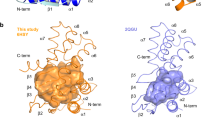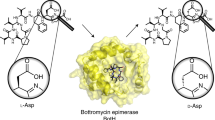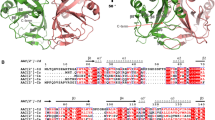Abstract
PENICILLIN acylase (penicillin amidohydrolase, EC 3.5.1.11) is widely distributed among microorganisms, including bacteria, yeast and filamentous fungi. It is used on an industrial scale for the production of 6-aminopenicillanic acid, the starting material for the synthesis of semi-synthetic penicillins. Its in vivo role remains unclear, however, and the observation that expression of the Escherichia coli enzyme in vivo is regulated by both temperature and phenylacetic acid has prompted speculation that the enzyme could be involved in the assimilation of aromatic compounds as carbon sources in the organism's free-living mode1. The mature E. coli enzyme is a periplasmic 80K heterodimer of A and B chains (209 and 566 amino acids, respectively2,3) synthesized as a single cytoplasmic precursor containing a 26-amino-acid signal sequence to direct export to the cytoplasm4 and a 54-amino-acid spacer between the A and B chains which may influence the final folding of the chains5. The N-terminal serine of the B chain reacts with phenylmethylsulphonyl fluoride, which is consistent with a catalytic role for the serine hydroxyl group. Modifying this serine to a cysteine6'7 inactivates the enzyme, whereas threonine, arginine or glycine substitution prevents in vivo processing of the enzyme7, indicating that this must be an important recognition site for cleavage. Here we report the crystal structure of penicillin acylase at 1.9 Å resolution. Our analysis shows that the environment of the catalytically active N-terminal serine of the B chain contains no adjacent histidine equivalent to that found in the serine proteases. The nearest base to the hydroxyl of this serine is its own α-amino group, which may act by a new mechanism to endow the enzyme with its catalytic properties.
This is a preview of subscription content, access via your institution
Access options
Subscribe to this journal
Receive 51 print issues and online access
$199.00 per year
only $3.90 per issue
Buy this article
- Purchase on Springer Link
- Instant access to full article PDF
Prices may be subject to local taxes which are calculated during checkout
Similar content being viewed by others
References
Burlingame, R. & Chapman, P. J. J. Bact. 155, 113–121 (1983).
Bock, A. et al. FEMS Microbiol. Lett. 20, 135–140 (1983).
Bock, A. et al. FEMS Microbiol. Lett. 20, 140–144 (1983).
Schumacher, G., Sizmann, D., Haug, H., Buckel, P. & Bock, A. Nucleic Acids Res. 14, 5713–5726 (1986).
Daumy, G. O., Danley, D. & McColl, A. J. Bact. 163, 1279–1281 (1985).
Slade, A. et al. Eur. J. Biochem. 197, 75–80 (1991).
Choi, K. S., Kim, J. A. & Kang, H. S. J. Bact. 174, 6270–6276 (1992).
Savidge, T. A. & Cole, M. Meth. Enzym. 43, 705–725 (1975).
Huang, H. T., Seto, T. A. & Shull, G. M. Appl. Microbiol. 11, 1–6 (1963).
Martin, J. et al. Biochim. biophys. Acta 1037, 133–139 (1990).
Kutzbach, C. & Rauenbusch, E. Hoppe-Seyler's Z. physiol. Chem. 354, 45–53 (1974).
Kraut, J. A. Rev. Biochem. 46, 331–358 (1977).
Konecny, J. Biotech. Lett. 3, 112–117 (1981).
Blow, D. M., Birktoft, J. J. & Hartley, B. S. Nature 221, 337–339 (1969).
Tanford, C. Adv. Protein Chem. 17, 69–165 (1962).
Virden, R. Biotechnol. Genet. Eng. Rev. 8, 189–218 (1990).
Cole, M. Biochem. J. 155, 733–739 (1969).
Robertus, J. D., Kraut, J., Alden, R. & Birktoft, J. Biochemistry 11, 4293–4303 (1972).
Strynadka, N. C. J. et al. Nature 359, 700–705 (1992).
Miller, M., Rao, J. K. M., Wlodawer, A. & Gribskov, M. R. FEBS Lett. 328, 275–279 (1993).
Hunt, P. D., Tolley, S. P., Ward, R. J., Hill, C. P. & Dodson, G. G. Prot. Engng 3, 635–639 (1990).
CCP4 Acta crystallogr. D 50, 760–763 (1994).
Brunger, A. T., Kuriyan, J. & Karplus, M. Science 23, 458–460 (1987).
Kraulis, P. J. J. appl. Crystallogr. 24, 946–950 (1990).
Lamzin, U. S. & Wilson, K. S. Acta crystallogr. D49, 129–147 (1993).
Author information
Authors and Affiliations
Rights and permissions
About this article
Cite this article
Duggleby, H., Tolley, S., Hill, C. et al. Penicillin acylase has a single-amino-acid catalytic centre. Nature 373, 264–268 (1995). https://doi.org/10.1038/373264a0
Received:
Accepted:
Issue Date:
DOI: https://doi.org/10.1038/373264a0
This article is cited by
-
Efficient side-chain deacylation of polymyxin B1 in recombinant Streptomyces strains
Biotechnology Letters (2022)
-
Penicillin G acylase production by Mucor griseocyanus and the partial genetic analysis of its pga gene
International Microbiology (2021)
-
Crystal structures and protein engineering of three different penicillin G acylases from Gram-positive bacteria with different thermostability
Applied Microbiology and Biotechnology (2019)
-
4-alkyl-L-(Dehydro)proline biosynthesis in actinobacteria involves N-terminal nucleophile-hydrolase activity of γ-glutamyltranspeptidase homolog for C-C bond cleavage
Nature Communications (2017)
-
Bifunctional quorum-quenching and antibiotic-acylase MacQ forms a 170-kDa capsule-shaped molecule containing spacer polypeptides
Scientific Reports (2017)
Comments
By submitting a comment you agree to abide by our Terms and Community Guidelines. If you find something abusive or that does not comply with our terms or guidelines please flag it as inappropriate.



